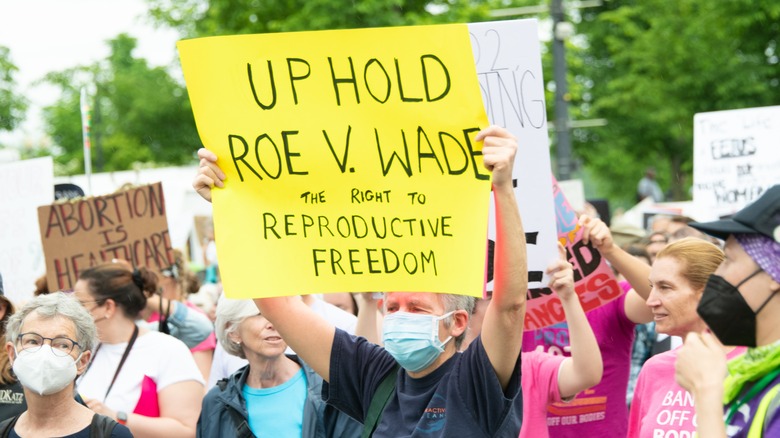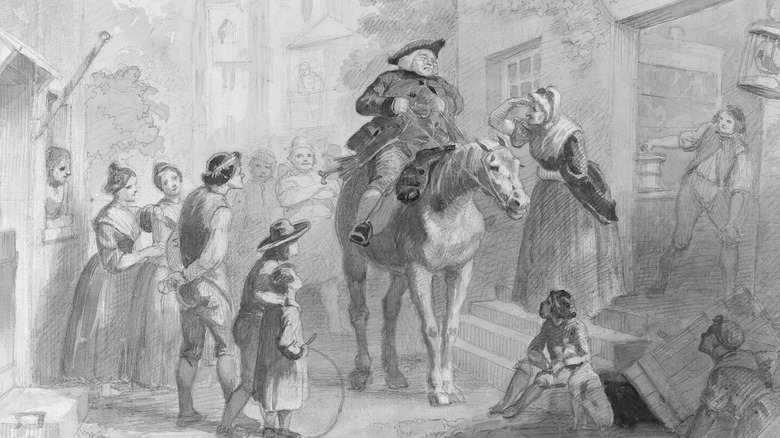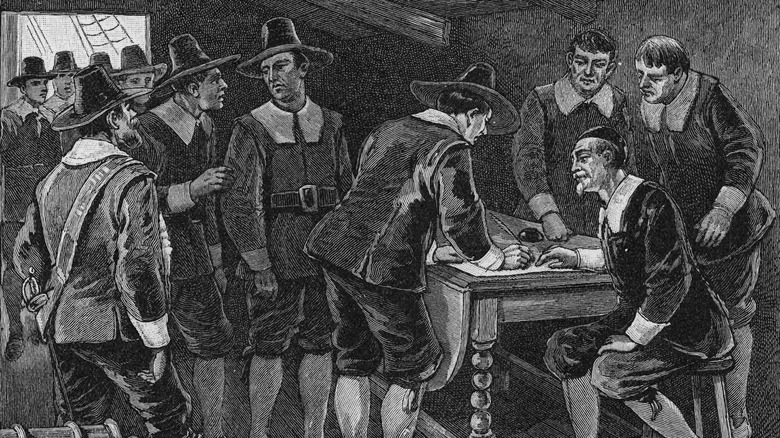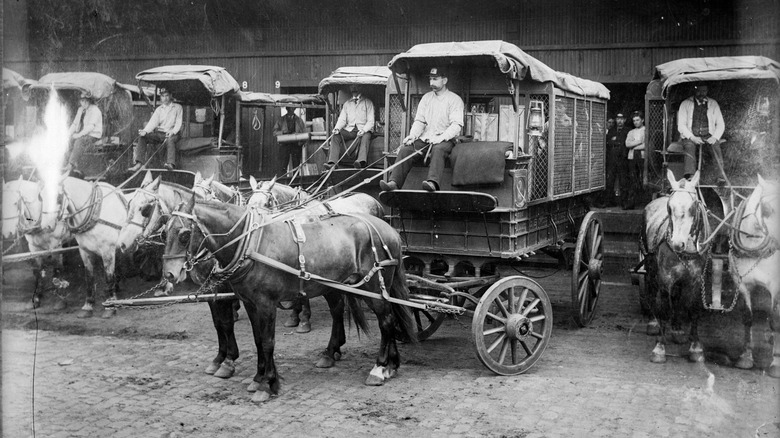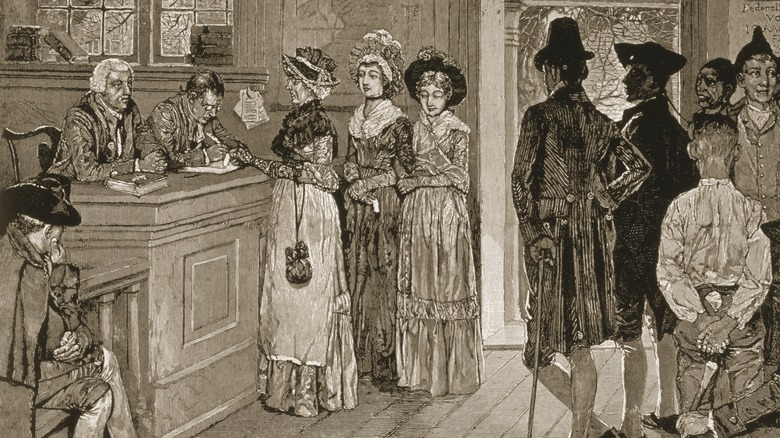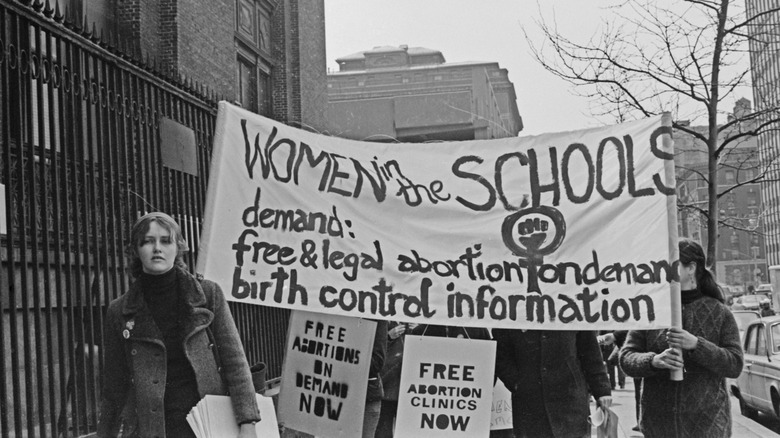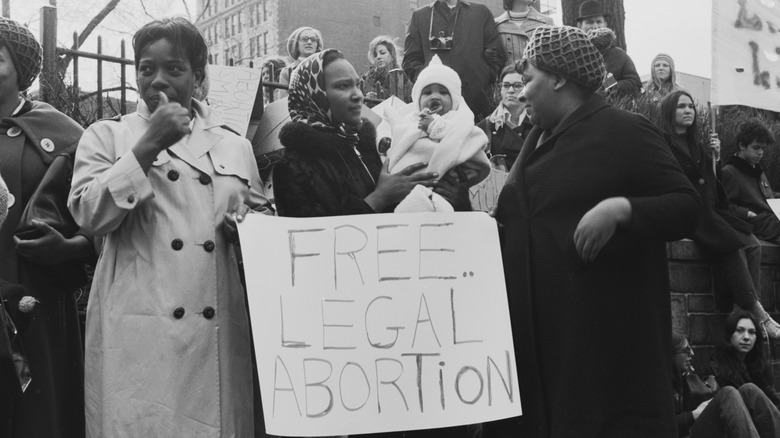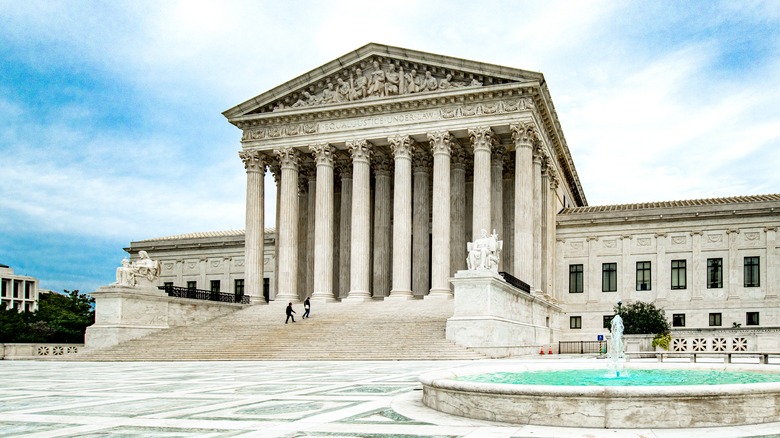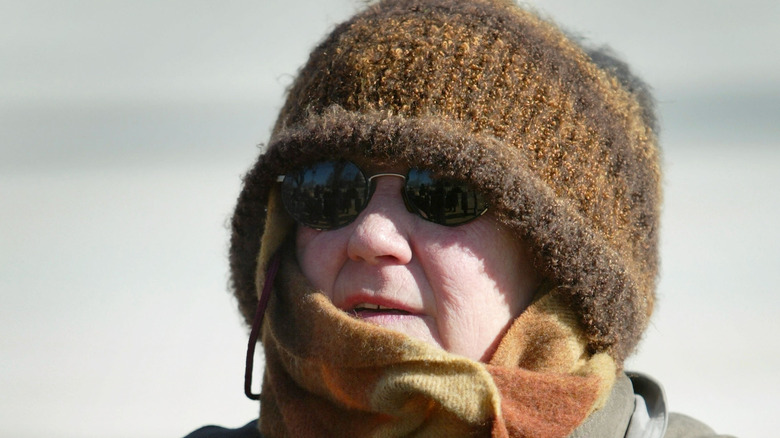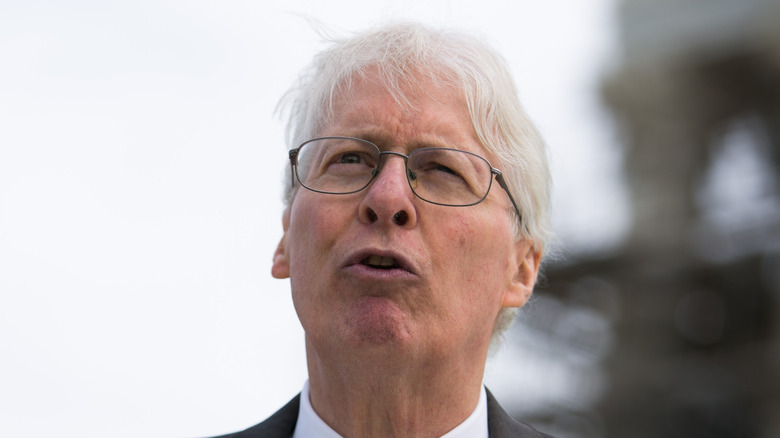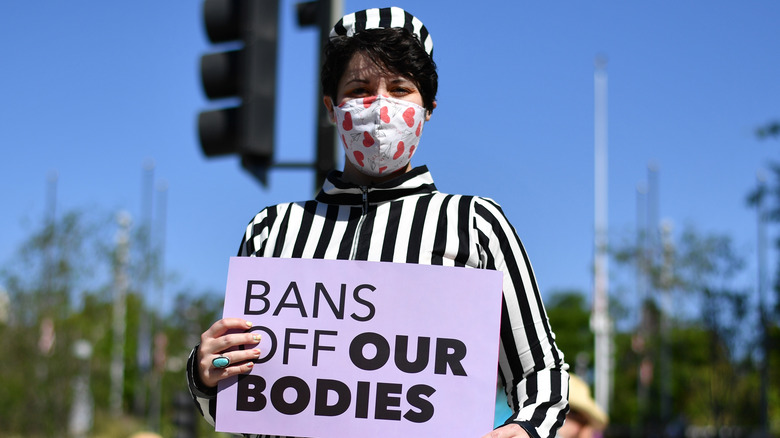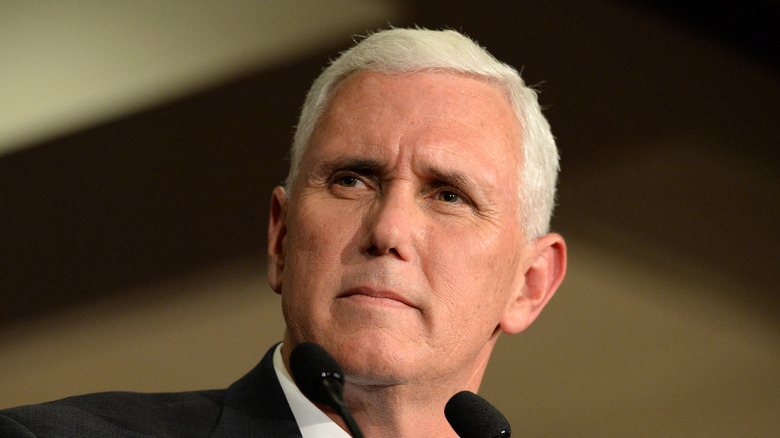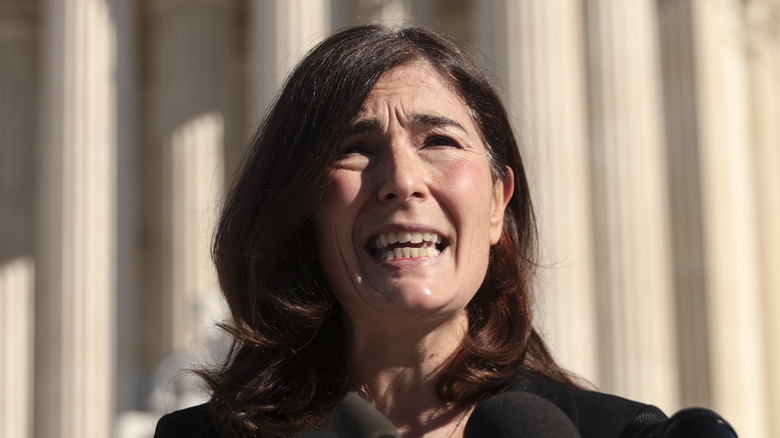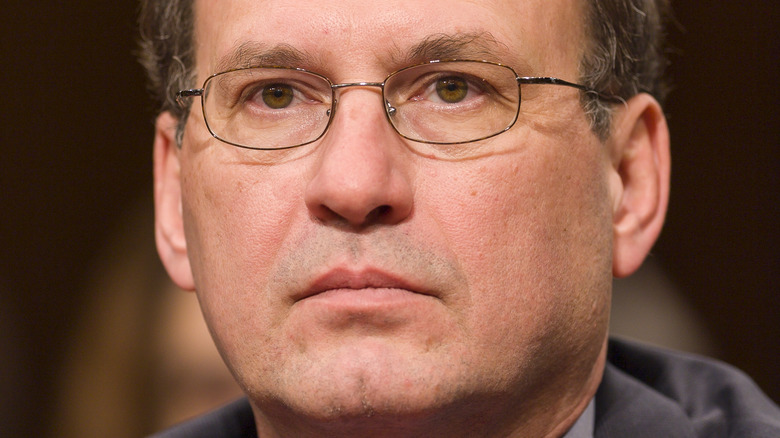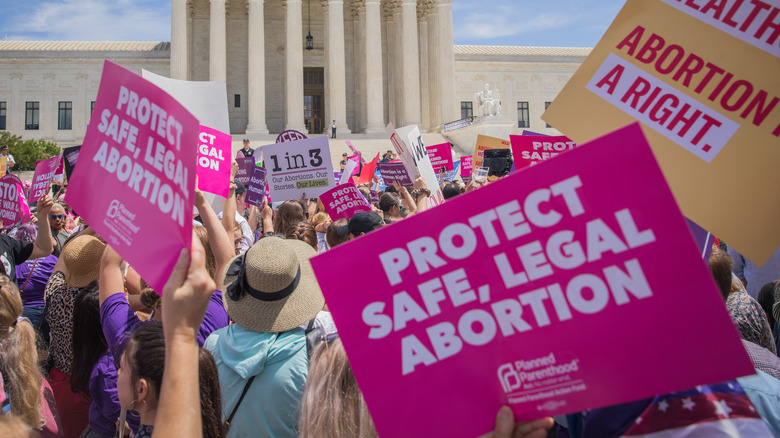The Roe V. Wade Timeline Explained
Abortion has been a hot button issue in American politics for as long as many of us can remember. In fact, it can seem like Americans have always been fighting about whether or not women have the right to make the important decision of whether to carry a child to term on their own — but the reality is that conversations about abortion in the United States have not always been so fraught and morally patrolled.
In the 1800s, many women in the former British colonies had the ability to obtain safe abortions performed by medical professionals. The procedure was eventually banned by the 1880s as part of an effort led by an anti-abortion gynecologist who also insisted that the best way to contend with a woman who had "become habitually thievish, profane, or obscene" was to remove her ovaries (per Timeline). In the century that followed, abortion — and the right to access it legally and safely — became a political issue that both the Republican and Democrat parties have had to contend with. Abortion was finally legalized in the U.S. in 1973 by the landmark case Roe v. Wade.
In June 2022, the Supreme Court of the United States overturned Roe v. Wade in a move that stunned reproductive rights activists around the country. But what is Roe v. Wade? What led up to the 1973 ruling, and what do women stand to lose now? Here is a look at the Supreme Court case — and what happens next in the wake of it being overturned.
Abortion laws were fairly liberal in the United States until the end of the 19th century
Abortion has a long history in the United States that predates the founding of the country itself. In fact, abortion laws leaned more to the liberal side until the late 19th century. For decades, abortion was legal in the colonies and the United States until a woman could feel "quickening," or the movements of a fetus, which typically occurs sometime in the fourth or fifth month of a pregnancy (via History).
Abortion in the Colonial-era North America was generally safe, and a study points to several supporting facts that offer a very different picture of what the procedure was like for different cultural and ethnic groups who lived in North America between the 1600s and the 1850s. Abortion was achieved in numerous ways, including using cedar root.
The degree to which abortion was legal in the country at the time varied depending on which European country had colonized that specific part of what would become the United States. As the study notes, abortion was illegal in Spanish and Portuguese colonies, was technically illegal in the French colonies but "frequently performed," and was legal in the British colonies if they took place before fetal movement was felt.
The American Medical Association called for criminalizing abortion in 1850
In 1850, the brand-new American Medical Association (AMA) began to discuss banning abortion. This plan was brought to the forefront of discussion by surgeon and gynecologist Horatio Robinson Storer, a vehement opponent of abortion rights for women. Storer lobbied the AMA to ban the procedure completely.
According to Timeline, Storer succeeded in convincing the AMA to establish the Committee on Criminal Abortion in 1857, and he was subsequently appointed to run that specific committee. Storer was a proponent of the ovariotomy, a procedure in which a woman had one or both of her ovaries removed, and in his paper "The Origins of Insanity in Women," he defended the practice to the AMA itself. It was his belief that if a woman had "become habitually thievish, profane, or obscene, despondent or self-indulgent, shrewish or fatuous," removing her ovaries was the only path forward.
Storer was also against the idea of keeping abortion legal until quickening was felt, writing to the AMA, "If we have proved the existence of foetal life before quickening has taken place or can take place ... we are compelled to believe unjustifiable abortion always a crime." Ultimately, the AMA agreed with Storer and held his opinion on abortion until 1967.
The Comstock Act of 1873 outlawed mailing abortion drugs and contraceptives
The Comstock Act of 1873 covered a lot, but most of it had to do with sex and sexuality in some way. The act made it a crime to send "obscene, lewd or lascivious" or "indecent" publications in the mail, which at the time included any writings that had to do with contraceptives and abortion — even prescriptions written by a doctor (via MTSU).
Upon passing the act, Congress named Anthony Comstock a special agent who had the ability to arrest people he believed were violating the ruling. For example, feminist author Ezra Heywood was arrested after releasing his work "Cupid's Yokes," in which he wrote that women should be able to make decisions about their bodies.
The National Liberal League and the National Defense Association asked Congress to repeal the act five years after its passage, but their request was denied.
Abortion was outlawed in most of the U.S. by 1880
By 1880, abortion was officially illegal in most of the United States. As CNN notes, the procedure was not completely banned, and women could still obtain abortions if their lives were in danger. The news organization notes that this addition was "not at the urging of social or religious conservatives but under pressure from the medical establishment."
Of course, making abortion illegal did little to stop both men and women seeking them. Feminist.com notes that an estimated 2 million abortions were performed each year in 1890s (and the population of the United States was approximately 63 million at the time, according to the Census Bureau). Unfortunately, what the ban did result in was an increase in deaths, as many women were unable to obtain safe abortions and ended up finding alternate means, such as using knitting needles and coat hangers inserted into their vaginas to achieve the goal of aborting the fetus.
Feminist.com also writes that getting an illegal abortion was dangerous in other ways. Some men who claimed to perform abortions charged up to $1,000 for abortions or even insisted on having sex with women before the abortion could be administered. Many people who performed abortions also wouldn't use anesthesia, as they wanted the women to be able to leave as quickly as possible.
The 1960s gave women more access to contraception
The tide began to turn in favor of women's bodily rights in the 1960s. Much as there were changes coming hard and fast for many groups of people, women saw gains in what they were allowed to do with their own bodies. The women's rights movement touted access to easy-to-use contraception as part of its platform, and there were several court cases that helped pave the way for future abortion rights (via History).
However, that does mean that these rights were enjoyed equally by all women. As Feminist.com notes, thousands of women were still dying from abortions gone wrong. Poor women, Black women, and women of color were the most likely to suffer at the hands of someone performing an illegal abortion; the site writes that in 1969, "75% of the women who died from abortions (most of them illegal) were women of color." On top of that, of the legal abortions that were performed that year, 90% of them were done for white women who had access to a private physician.
Hawai'i was the first state to legalize abortion in 1970
In 1970, Hawai'i became the first state in the United States to legalize abortion. The state was still in its infancy in and of itself, having only joined the United States in 1959 following a protracted battle that saw its queen captured and imprisoned against her will (via History).
Hawai'i laws pertaining to abortion were liberal and broad. The University of Hawai'i notes that the stipulations were as follows: Abortions had to be performed by a licensed doctor at an established hospital that was accredited, had to be completed before the fetus was viable outside the womb, and a woman had to be a resident of Hawai'i for at least 90 days before she could receive the abortion in the first place.
The University also writes that the abortions performed in the state cost at least $300 at the time, and the average patient paid between $350 and $400.
A pregnant single woman filed Roe v. Wade in 1971
A woman in Texas by the name of Norma McCorvey got pregnant in 1969 and began the process of finding out how she could get an abortion. This was McCorvey's third pregnancy, as she had already given birth to two children, whom she had placed for adoption. McCorvey could only get an abortion in Texas if her life was in danger, and she couldn't afford to pay a private doctor who might offer the procedure (per History).
McCorvey attempted to get an illegal abortion first but couldn't make it happen, and she was eventually referred to lawyers Linda Coffee and Sarah Weddington, who were hoping to challenge anti-abortion laws in the United States. The women filed a lawsuit on behalf of "Jane Roe" in 1970, against the District Attorney of the Texas county where she lived, Henry Wade.
In June of 1970, the state of Texas ruled that the abortion ban was illegal. The case was appealed and made its way all the way to the Supreme Court of the United States.
The Supreme Court released its ruling on Roe v. Wade in 1973
The Supreme Court finally ruled on Roe v. Wade four years after Norma McCorvey had fallen pregnant. In fact, McCorvey ended up giving birth to the baby and placing her for adoption, too. On January 22, 1973, the Supreme Court of the United States ruled 7-2 against the Texas law, which in turn made abortion legal nationwide. The court concluded that the 14th amendment gives women the right to privacy when making medical decisions for themselves (via History).
Journalist Joshua Prager spent eleven years working on a book about McCorvey. After his book's publication, Prager told Niemen Reports that researching McCorvey was challenging because she was a prolific liar. He admits that once he understood this about McCorvey, he was able to interview her and her three daughters, including Shelley Lynn Thornton, who was the baby at the center of the Roe v. Wade lawsuit.
Norma McCorvey didn't try to meet Shelley Thornton until she had grown up
Norma McCorvey and the baby at the center of the Roe v. Wade lawsuit didn't have a relationship throughout the baby's childhood. Shelley Lynn Thornton was adopted by Ruth and Billy Thornton when she was three days old. She grew up knowing she was adopted, but had no idea that she was the fetus whose existence began the abortion debate in the first place (via The Atlantic).
McCorvey began looking for Shelley Thornton in 1990. She began a full-on media campaign that she hoped would conclude in the two meeting. While being interviewed on the "Today" show, she was asked what motivated her search — and it seemed she didn't have an answer. McCorvey hadn't looked for her second daughter, who had been adopted by another couple (her first had been adopted by her own mother).
When Shelley found out McCorvey was her birth mother, she was devastated, as she and her family didn't support reproductive rights, including abortion. Shelley wasn't interested in meeting McCorvey, telling news outlets at the time, "In some ways, I can't forgive her ... I know now that she tried to have me aborted" (via The Atlantic). The two never met before McCorvey's death in 2017.
The National Right to Life Committee began fighting abortion rights in 1978
Abortion wasn't legal in the United States for long before political and religious groups in the country began to fight against it. In 1978, James Bopp, the general consul of the National Right to Life Committee, hatched a plan to decimate Roe v. Wade slowly — incrementally, as Vox writes. Bopp went on to spend forty years working with states and cities to create rules, provisions, and laws that would chip away at the foundation of the nationwide decree. Bopp also worked closely with the Republican Party to work anti-abortion rhetoric into the party's platform.
To date, the National Right to Life Committee continues to spread misinformation about reproductive rights in the United States. As American Progress notes, the organization's official website states that abortions were performed by "a few rogue doctors and midwives" as far back as 1850, while the truth is that abortions were performed safely throughout pre-American and post-Colonial North America by trusted leaders and medical professionals.
Ronald Reagan's presidential run brought abortion to the national forefront in 1980
Anti-abortion activists and organizations were aided by the presidential run of actor Ronald Reagan in 1980. Both Catholics and Evangelical Christians joined forces to elect Reagan as president of the United States, and the groups united in part because of their shared disdain for abortion, reproductive rights, and autonomy for women.
The groups were also aided by the Moral Majority, which was founded by religious leader Jerry Falwell in 1979. The Moral Majority is credited with laying down the foundation for a religious, conservative movement in the United States, which would go on to have long-lasting effects on many aspects of life, not limited to abortion and reproductive rights (per Britannica).
Falwell once told the Lynchburg News that Roe v. Wade was the motivation he needed to move forward. As he put it, "I sat there staring at the Roe v. Wade story, growing more and more fearful of the consequences of the Supreme Court's act and wondering why so few voices had been raised against it" (via Politico).
The Supreme Court placed new restrictions on abortion in 1992
In 1992, it seemed that conservative and religious efforts to chip away at the foundation Roe v. Wade established were beginning to work. In the case Planned Parenthood of Southeastern Pennsylvania v. Casey, the Supreme Court of the United States (SCOTUS) declared that individual states could impose restrictions on abortion if those restrictions did not place an "undue burden" on pregnant women looking to have an abortion. SCOTUS also decided that the trimester of the pregnancy could be used as the parameter for deciding what point an abortion was no longer allowed to be performed. In the end, many of the restrictions the state of Pennsylvania wanted to keep in place were allowed to remain by the ruling (per Vox).
The case was filed after Pennsylvania began requiring married women to tell their husbands if they planned to have an abortion and minors to tell their parents if they planned to have an abortion. The state also required clinics to give women who were seeking abortions specific information and make them wait 24 hours to have the procedure done. Planned Parenthood of Southeastern Pennsylvania sued the state to prevent the measures from being enacted (via Britannica).
In 2011, a number of anti-abortion restrictions were passed
Things began to grow more dismal for women who needed abortions and abortion rights activists in 2011. As part of his attempt to pass the Affordable Care Act (ACA) in 2010, President Barack Obama had to appeal to anti-abortion Democrats to make it happen. The ACA included the Boxer-Nelson Amendment, which is largely seen as a deal between reproductive rights activists and anti-abortion lawmakers. In a nutshell, the amendment gave insurance providers the option to refuse to cover abortions in plans provided by the ACA (per Vox).
In 2011, the U.S. House of Representatives passed an amendment put forth by then-Senator Mike Pence. The amendment was designed to defund Planned Parenthood. The amendment failed to pass in the U.S. Senate, but Vox notes that it did result in driving further wedges between the Republican and Democrat parties in the United States, and gave the Tea Party more fuel for its own efforts to impose more restrictions on the right to abortion.
As President, Donald Trump nominated three justices who are anti-abortion
Former President Donald Trump may not have been in office long, but he had the ability and time to nominate three different justices to the Supreme Court of the United States (SCOTUS) — three justices who could be relied upon to uphold conservative positions and beliefs. A month before he was elected to office, Trump told news organizations that this was both his hope and intent when he said, "Well, if we put another two or perhaps three justices on, that ... will happen automatically in my opinion because I am putting pro-life justices on the court" (via CTV News).
Trump appointed Neil Gorsuch (2017), Brett Kavanaugh (2018), and Amy Coney Barrett (2020). He was also the first President of the United States to attend the March for Life event in 2020. He celebrated his appointments at the time, saying, "Unborn children have never had a stronger defender in the White House."
Dobbs v. Jackson Women's Health Organization was introduced into the Supreme Court in 2021
The lawsuit Dobbs v. Jackson Women's Health Organization was first filed in March 2018. The case was filed by the Center for Reproductive Rights in an attempt to support Jackson Women's Health Organization in its attempt to upend the state of Mississippi's ban on abortion after 15 weeks of gestation. Jackson Women's Health Organization is the only hospital in the state of Mississippi that provides abortions (via the Center for Reproductive Rights).
At first, things were working in favor of the Center for Reproductive Rights. A federal court blocked Mississippi's 15-week ban, noting its belief that the state of Mississippi had attempted to pass the ban in an attempt to have Roe v. Wade overturned. The state filed its own petition with the Supreme Court of the United States (SCOTUS) in June 2020, and the court opted to hear the appeal in 2021.
The Center for Reproductive Rights argued vehemently against the ban, with its lawyer Julie Rikelman telling SCOTUS, "For a state to take control of a woman's body and demand that she go through pregnancy and childbirth, with all the physical risks and life-altering consequences that brings, is a fundamental deprivation of her liberty" (via the Center for Reproductive Rights).
Justice Alito's opinion on the overturn of Roe v. Wade was leaked in 2022
In May 2022, abortion rights activists were startled to learn that a leaked opinion authored by Supreme Court Justice Alito appeared to reveal that the Supreme Court of the United States (SCOTUS) intended to overturn Roe v. Wade. The draft opinion that was leaked wasn't a mere rebuttal of the law — the opinion seemed to make it clear that everything Roe v. Wade stood for was under imminent threat (via Politico).
In the document, Justice Alito wrote in part, "We hold that Roe and Casey must be overruled. It is time to heed the Constitution and return the issue of abortion to the people's elected representatives."
There was hope that the decision might not be final, and in fact, some posited that it had been leaked in hopes that the opinion would be reversed. As Politico wrote at the time of the leak, "Justices can and sometimes do change their votes as draft opinions circulate and major decisions can be subject to multiple drafts and vote-trading."
The Supreme Court overturned Roe v. Wade in June 2022
A month after Justice Alito's majority draft opinion about the overturning of Roe v. Wade was released, the Supreme Court of the United States (SCOTUS) officially overturned the landmark 1973 lawsuit that granted women the right to abortion. SCOTUS ruled that obtaining an abortion is no longer a federal right that women in the United States hold, a move that many fear will completely change the state of reproductive rights in the United States of America (via CNN).
Justice Alito made it clear he holds nothing but contempt for Roe v. Wade, writing in his opinion, "Roe was egregiously wrong from the start. Its reasoning was exceptionally weak, and the decision has had damaging consequences" (via CNN). The ultimate vote was 6-3 in favor of overturning the decision, with Justices Stephen Breyer, Sonia Sotomayor, and Elena Kagan providing the votes against doing so. The three issued their own opinion against overturning Roe v. Wade, writing, "With sorrow — for this Court, but more, for the many millions of American women who have today lost a fundamental constitutional protection — we dissent" (via CNN).
There are at least 21 states in the United States who appear poised to ban abortion completely, as forecast by the Guttmacher Institute. President Joe Biden commented, "It's a sad day for the court and for the country" (via CNN).
